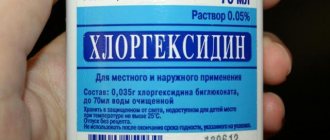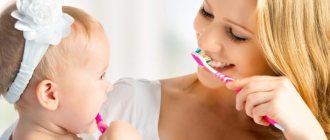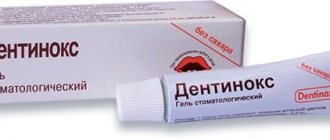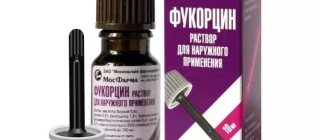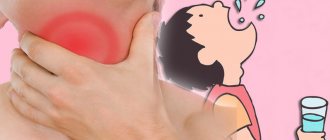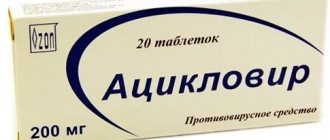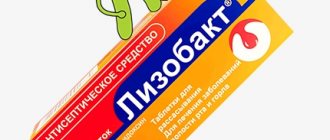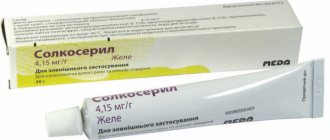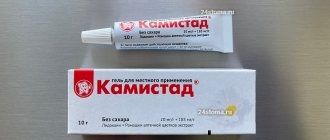Indications for use
The medicine is widely used in various branches of medicine. Miramistin for a sore throat in a child not only helps get rid of the infection, but also prevents its spread to other organs.
When to take the medicine:
- treatment and prevention of suppuration in surgery;
- elimination of STIs, prevention of inflammation in the female reproductive system in gynecology;
- treatment of burnt skin surfaces;
- various skin diseases;
- treatment of urethritis in urology.
Miramistin is also intended for complex therapy of pharyngitis or tonsillitis in children. The medicine can be used for children from the age of three. It is not recommended to treat a baby, especially without the permission of the pediatrician.
Side effects
Patients and doctors note the high degree of safety of the drug. Serious side effects from its use are rare.
However, this only applies to the case when the drug is used externally. It should be remembered that Miramistin is not an antibiotic and cannot be taken orally. The instructions for the drug do not say anything about whether accidental ingestion of the drug is dangerous, for example, if the patient gargles with it. Most likely not, but you shouldn’t do it intentionally. It is unknown how the gastrointestinal tract may react to the substance entering it. Irritation of the mucous membrane of the esophagus or stomach is possible.
However, in some cases, Miramistin can cause allergic reactions, redness of the skin, and burning at the site of application.
If a burning sensation is observed for 15-20 seconds and then goes away on its own, then discontinuation of the drug is not required. If unpleasant symptoms do not go away, then use of the drug must be stopped.
Another advantage of the drug is its lack of odor. But regarding the taste of the drug (when used to treat oral infections), opinions are divided. Some argue that the drug has no taste, others claim that the drug has a not very pleasant, but still not unpleasant, aftertaste. This may be due to the fact that the drug can cause a temporary disturbance in the sense of taste.
Miramistin is also gentle on the skin and mucous membranes, does not cause irritation, and does not change their color, unlike many other antiseptics. However, here it is necessary to remember to comply with the doctor’s instructions. If the drug is used systematically for a long time (more than 10 days), for preventive purposes, the patient may develop dysbiosis and associated inflammation of the mucous membranes or skin.
In addition, the standard Miramistin solution is not intended for instillation into the eyes. For this purpose, there is a special drug containing Miramistin - Okomistin.
Miramistin Komarovsky
Autumn has come, and the feed is full of posts about Viferons, Kagocels, Erespals, Isofras and other non-pediatricians’ favorite nonsense... Dear ones, no one needs the health of your children except you!!! Mom herself should know physiology, know about immunity and MODERN ADEQUATE methods of treatment. I am writing this post because the fool herself listened and poisoned the children, pouring liters of protargol, isofra into their noses, infusing erespal, expectorants and mucolytics. As a result, the children were sick for 2 weeks and were always covered in snot and coughing. I was looking for a “magic” pill, went to doctors with my children, bought herbal immunomodulators, vitamins and could not understand why I was so unlucky and it was my children who were constantly getting sick. But when the children themselves began to involuntarily show that they had been HEALED, I began to delve into this topic and want to share with you! So, time-tested (I’ve been “treating” children this way for a year and a half) sources of information on the treatment of banal, uncomplicated ARVI:
Modern approach to the treatment of ARVI
Information from Rusmedserver (a forum of doctors who adhere to evidence-based medicine) and more. If you have any specific questions, go to the forum and read the FAQ section Pediatrics. There on the forum in the SEARCH column you can enter a diagnosis or the name of a medicine and read what doctors and people write about this . We learn to analyze, collect information, generalize and draw conclusions.
Dr. Komarovsky’s website and his book “ARD: A Guide for Sensible Parents”
There is a wonderful pediatrician, Anna Levadnaya, who runs a website and an active blog on Instagram. She talks very clearly and popularly about the treatment of ARVI (it does not always coincide 100% with evidence-based medicine, but in general her recommendations are adequate and useful)
Very good selection of material from the Rostovmama forum
Let me briefly summarize:
1. We do not use pherons and immune stimulants (I’m not talking about children with serious problems - oncology, impaired immune status)
2. We do not use antivirals (only in case of flu it will be Tamiflu)
3. If the child is sick: often ventilate, wet cleaning, humidifier, walks if there is no temperature. At home we try to maintain a temperature of 20-22 degrees, at night 18-20 degrees, humidity not lower than 50%.
4. You can drip or splash salt solutions (Aqualor, Aquamaris and others) into the spout, or you can simply buy saline solution (now a very convenient format - in plastic bottles of 5 and 10 ml). We drip at least every hour. If the child cannot breathe - vasoconstrictor, but not more than 5 days. The color of the snot doesn't matter. If the snot is thick and your nose is clogged, just drip saline solutions more often.
5. Drinking plenty of warm fluids, percussion massage (put the child on your knees, hang your head) and with tense fingertips we tap on the entire surface of the backrest helps with coughing. This will make it easier for your child to cough up. We have one task - to make the cough productive, wet, so that the child can cough up phlegm. Alkaline drinking often helps: I give mineral water without gas (Essentuki, Borjomi) a dessert or tablespoon several times a day, and I also give milk with honey-butter-soda for an annoying cough (soda is the same alkali).
6. With ARVI, the child’s throat will be red. If it doesn’t hurt, there’s no reason to go there again. The redness will go away on its own when the body defeats the virus. It is good to rinse the neck with warm boiled water, you can add a little salt and soda on the tip of a knife. You can rinse with chamomile. The main thing is to rinse with warm water 3-4 times a day. Frequent use of Miramistin (for preventive purposes, with a red throat only leads to a decrease in local immunity, we also went through this). I like this article with photographs of the throat, it shows that white plaque in the tonsils is not always a sore throat and different conditions are described)
7. If the doctor suspects a child has a sore throat, do not rush to give antibiotics!!! We read the Rusmedserver and go to the pharmacy for streptatest! With its help, you can determine at home in a matter of minutes whether this is really a sore throat that requires treatment with antibiotics. Unfortunately, I also had such an experience; at that time I did not know about such subtleties and in vain I fed the child antibiotics for 5 days.
8. If a child has a fever for more than 3 days, then this is only a reason to donate blood and see if there is a bacterial infection. With viral diseases, the temperature can last up to 5 days, and sometimes more. But we always look at the child!
9. As an immunologist told me: the main thing for children’s health is not pills, but an active lifestyle! Children should engage in active sports and spend more time outside. If you choose a club, let it be a sports section!
With this “treatment” (although we do not cure, we simply create conditions for the body to defeat the virus on its own), you will notice how a frequently ill child will get sick less often in a few months and will get better in 3-5 days. And the money that was previously spent on medicine can be spent on other family expenses =)
In case of suspected complications (otitis media, bronchitis, etc.), we look for adequate doctors and all prescriptions can be double-checked on the Russianmedserver. Literally in the spring, 2 doctors at the clinic diagnosed Maxim with bronchitis, but Anna Levadnaya, even over the phone, realized that this was a residual cough that just needed to be moistened more actively, and after an in-person examination she confirmed this.
And in conclusion, a wonderful article by Komarovsky, which was the stimulus for my “epiphany”: A frequently ill child. Who is to blame and what to do?
Release form and composition
The medicine is presented as a clear solution that does not have any odor, taste or color. Such a liquid includes only two ingredients - the active substance, also called miramistin, and purified water. The concentration of the active compound is 0.01%.
In pharmacies you can see different packages of Miramistin, differing in both volume and attachments. In childhood, a bottle of 150 ml of medication is most often recommended, to which a nebulizer can be attached. But for the youngest patients, smaller packaging is also suitable - bottles of 50 ml of solution, which have two nozzles (urological and spray).
The shelf life of the medicine is 3 years and after its expiration the medicine should be thrown away. Storing the solution does not require any special regime - it is recommended to keep the package of medicine out of the reach of children at room temperature. You do not need a prescription to purchase Miramistin at a pharmacy. The average price of 150 ml of the drug is approximately 350 rubles.
Can Miramistin be used for children under 1 year of age?
The instructions for use of the medication contain information that it can be given to children over 3 years of age. For this reason, many parents have a question about whether it can be used when most pediatricians prescribe Miramistin to newborns and children up to one year old. This purpose is due to the fact that the drug is harmless to the health of the child. Doctors often recommend that parents use Miramistin for painful throat conditions in children, including children under 1 year of age and newborns.
Even a small amount of medicine can alleviate the child’s condition. For babies under 1 year of age, it is used topically. Immediately after use, it reduces the inflammatory process in the throat mucosa. Unlike other medicinal liquids, it cannot be given to infants. Pediatricians only recommend spraying it so that it dissolves throughout the mucous tissues in doses that are safe for the small body.
Miramistin has an active antifungal and bactericidal effect. It is a fairly powerful antiseptic that can be used by babies from the first months of life. The range of application of the drug is very extensive:
- the first manifestations of colds and acute respiratory viral infections;
- thrush;
- damage to the skin;
- conjunctivitis;
- stomatitis;
- gingivitis;
- pneumonia;
- laryngitis;
- angina.
To treat infected wounds for children under one year of age, apply the solution to a napkin or gauze and apply a compress to the affected area. A big problem is applying the product to the throat mucosa of a newborn. There is no need to dilute the product before use, since it is already ready to actively combat harmful bacteria and microbes.
Important Prospan during pregnancy: 1st, 2nd, 3rd trimester, instructions for use, reviewsThere are several ways in which Miramistin can be administered to infants in the throat:
- It is recommended to spray the solution on the pacifier and give it to the baby; it, along with saliva, will fall on the mucous membrane of the throat;
- you can wrap gauze soaked in Miramistin on your finger or spatula and then wipe the mucous membrane;
- For treatment, cotton swabs soaked in a solution of the medicine are also used, but a single dose should not exceed more than 5 drops of the product;
- instillation into the nose should be performed once a day and only after rinsing the nasal passage with saline or saline;
- using a spray bottle, if the baby manages to insert the tip of the bottle into his mouth.
In severe cases of gingivitis and stomatitis, it is necessary to apply the medicine directly to the affected areas. It is best to perform the procedure immediately after feeding the baby. You need to prepare the oral cavity by treating it with water and then apply the product 3-4 times a day. To treat the respiratory system, it is good to use the medicine using an inhalation nebulizer.
Failure to comply with the dosage can lead to increased dryness of the baby's mucous membranes. Immediately after treatment, a slight tingling sensation appears, which often causes discomfort for infants. If you are hypersensitive to the main substance, it is not recommended to use Miramistin.
Despite the fact that the drug is practically safe, it can cause an allergic reaction in a child if his body is too sensitive. If parents know about this, they should notify the pediatrician in advance. Hypersensitivity is the only contraindication to the use of Miramistin.
Almost always, the child’s body reacts positively to the use of the product. Its effect can be noticed after 4-5 procedures. If the baby accidentally swallows the permissible dose of the solution, nothing terrible will happen. It settles in microscopic drops in the nasopharynx and does not cause poisoning.
Miramistin®
The drug is ready for use.
Instructions for using the packaging with spray nozzle:
1. Remove the cap from the bottle and also remove the urological applicator from the 50 ml bottle.
2. Remove the supplied spray nozzle from its protective packaging.
3. Attach the spray nozzle to the bottle.
4. Activate the spray nozzle by pressing again.
Surgery, traumatology, combustiology.
For preventive and therapeutic purposes, the surface of wounds and burns is irrigated, wounds and fistula tracts are loosely tamponed, gauze swabs soaked in the drug are fixed. The treatment procedure is repeated 2-3 times a day for 3-5 days. A highly effective method of active drainage of wounds and cavities with a daily consumption of up to 1 liter of the drug.
Obstetrics, gynecology.
In order to prevent postpartum infection, it is used in the form of vaginal irrigation before childbirth (5-7 days), during childbirth after each vaginal examination and in the postpartum period, 50 ml of the drug in the form of a tampon with an exposure of 2 hours, for 5 days. When women give birth by cesarean section, the vagina is treated immediately before the operation, the uterine cavity and the incision on it are treated during the operation, and in the postoperative period tampons soaked in the drug are inserted into the vagina with an exposure of 2 hours for 7 days. Treatment of inflammatory diseases is carried out over a course of 2 weeks by intravaginal administration of tampons with the drug, as well as by the method of medicinal electrophoresis.
Venereology.
For the prevention of sexually transmitted diseases, the drug is effective if it is used no later than 2 hours after sexual intercourse. Using a urological applicator, insert the contents of the bottle into the urethra for 2-3 minutes: for men (2-3 ml), for women (1-2 ml) and into the vagina (5-10 ml). Treat the skin of the inner thighs, pubis, and genitals. After the procedure, it is recommended not to urinate for 2 hours.
Urology.
In the complex treatment of urethritis and urethroprostatitis, 2-3 ml of the drug is injected into the urethra 1-2 times a day, the course is 10 days.
Otorhinolaryngology.
For purulent sinusitis, during puncture the maxillary sinus is washed with a sufficient amount of the drug. Tonsillitis, pharyngitis and laryngitis are treated by gargling, throat and/or irrigation using a spray nozzle, pressing 3-4 times, 3-4 times a day. The amount of drug per rinse is 10-15 ml.
In children.
In case of acute pharyngitis and/or exacerbation of chronic tonsillitis, the pharynx is irrigated using a spray nozzle. Children aged 3-6 years: by pressing the head of the spray nozzle once (3-5 ml per irrigation), 3-4 times a day; for children aged 7-14 years, double pressing (5-7 ml per irrigation), 3-4 times a day; for children over 14 years old, press 3-4 times (10-15 ml per irrigation) 3-4 times a day. The duration of therapy ranges from 4 to 10 days, depending on the timing of remission.
Dentistry.
For stomatitis, gingivitis, periodontitis, it is recommended to rinse the mouth with 10-15 ml of the drug 3-4 times a day.
Is it possible for children to swallow Miramistin?
In the instructions, manufacturers do not indicate the likelihood of swallowing the product and the possible consequences. But it would be advisable not to allow large amounts of the drug to enter the stomach. As for the dose of medicine that gets inside during rinsing and irrigation, it is so insignificant that it is safe even for children. The drug does not cause a burning sensation or redness after use, even on the mucous membranes.
Despite the safety of the ingredients, this does not mean that you can use the product thoughtlessly or leave it unattended. The instructions mention that, like any medicine, it should be stored out of reach of younger family members. This could be the top section of a cabinet or a high-hanging shelf.
It’s good if the storage location is locked with a key. In addition, storage conditions must be observed in accordance with the instructions. Namely: it should be a room with a temperature not exceeding +25 degrees. Therefore, you should avoid storing in places close to central heating or in direct sunlight during the summer months.
Contraindications Miramistin
There is no prohibition on the use of this antiseptic in pregnant and lactating women, since the drug has no resorption and the active component will not be passed on to the child. Miramistin also does not have an impressive list of contraindications: only individual intolerance, which will be expressed by an allergic reaction of the skin.
It is advisable for children to follow the precautions specified in the instructions
Terms of sale and storage
Miramistin can be freely purchased at any pharmacy (the only difficulty is purchasing the ointment); it is dispensed without a doctor's prescription. The bottle with the solution (both the spray and the classic version) should be stored in a cool place - the air temperature should not exceed 25 degrees. The shelf life is 3 years, the date of opening does not matter.
Miramistin for children
If we consider the list of the safest medicines that have antiseptic properties and are approved for use even in infants, Miramistin will take the first place. It is used in almost all medical fields:
- gynecology;
- otolaryngology;
- dentistry;
- dermatology;
- venereology;
- surgery;
- urology;
- combiustiology.
The only point that continues to cause controversy among doctors is the degree of effectiveness. According to official data, the Ministry of Health conducted only 1 clinical trial aimed at assessing the safety of the drug when used as part of vaginal suppositories (for the treatment of thrush). However, this does not negate the possibility of using the drug in children of any age, since there are no worthy analogues.
Composition and release form
Initially, pharmacies offered only a solution in plastic bottles with a long narrow spout, which could be used to squeeze out the drug drop by drop. Afterwards, pharmaceutical companies released 2 more versions:
- Spray differs from solution only in the presence of a removable sprayer, as can be seen from the photo. The concentration is the same (0.01%), the liquid is colorless. If you shake the bottle, the solution will foam. The spray comes in volumes of 50, 150 and 300 ml.
- Ointment - sold in small tubes of 15 and 30 g. It is difficult to buy this form in Russia, since the manufacturer is Ukraine.
The suppositories mentioned above, which are used in gynecology, are a combination medicine containing miramistin and methyluracil, and therefore are not included in the list of the main forms of release of this antiseptic. The composition of the solution is as simple as possible - only benzyldimethylmyristoylaminopropylammonium chloride monohydrate and pure water. The ointment has a large number of ingredients:
| Active components (per 1 g) | Excipients |
| Miramistin (5 mg) | Propylene glycol |
| Edetate disodium | |
| Macrogol 500, 1500, 6000 | |
| Proxanol 268 | |
| Water |
Effect of the drug
The official instructions classify Miramistin in the group of antiseptics and note that it has pronounced antimicrobial qualities: it can even influence nosocomial strains of pathogenic bacteria that are resistant to antibiotics. Miramistin mainly works against:
- gram-positive microorganisms (streptococci);
- gram-negative bacteria;
- aerobic/anaerobic pathogens;
- penicillin fungi;
- yeast/yeast-like fungi;
- dermatophytes;
- herpes virus and human immunodeficiency;
- causative agents of sexually transmitted diseases.
Important Prospan Drops: instructions for use for children and adults, composition, reviews
This antiseptic drug is also capable of preventing infections in the area of a burn or open wound and stimulating skin regeneration. This is explained by the activation of the digestive and absorbing functions of phagocytes and the monocyte-monophagal system. The use of Miramistin is also relevant in the presence of purulent inflammation, since it absorbs pus. Absorption through the skin and mucous membranes does not occur when applied topically.
Indications for use
In patients of all ages - from infants to adults - Miramistin solution can be used to carry out antiseptic treatment of the mucous membrane or skin in the treatment of wounds and burns, or:
- for fungal skin diseases (especially candidiasis, dermatomycosis);
- for the treatment of stomatitis, gingivitis, periodontitis;
- for the treatment of runny nose, sinusitis, external otitis, purulent tonsillitis, pharyngitis;
- for chronic tonsillitis (part of complex therapy);
- for sexually transmitted infections;
- for the treatment of conjunctivitis (in young children);
- as a prevention of purulent inflammation after childbirth;
- in case of acute urethritis.
Miramistin ointment has a smaller spectrum of action - instructions for use for children and adults indicate the possibility of its use only in dermatology, surgery and combustiology. It is used to treat burns and wounds, bedsores, fistulas, ulcers; it can be effective for skin diseases and fungal infections, frostbite and during preparation for skin grafting.
How it works?
The active ingredient of the drug, benzyldimethyl, acts on the bacterial membrane, destroying it. It reacts exclusively with pathogenic bacteria (including those that are resistant to antibiotics), without causing any damage to the baby’s mucous membranes and skin. Miramistin is effective against all known types of bacteria:
- staphylococcal;
- streptococcal;
- anaerobic and aerobic;
- spore-forming and asporogenic.
"Miramistin" suppresses fungal microorganisms - dermatophytes, ascomycetes and yeast-like fungi. It is also effective against a number of sexually transmitted diseases that can be transmitted from mother to child.
Dosage: general data
Infancy is a problem when a child gets sick, so any mother worries about how to treat and what medications can be used.
Miramistin, being an antiseptic, is produced for external use. Its components can relieve the inflammatory process that affects the baby’s mucous membranes and skin.
Due to the fact that a few drops of this remedy are enough to improve the patient’s condition, it is prescribed for the treatment of babies, in particular, children under one year old. Its range of applications is wide:
- This drug perfectly treats various ENT diseases.
- It is used to disinfect a child's dirty hands.
- It is used to treat inflamed body folds.
Due to their restless nature, some mothers are afraid to drop Miramistin into the baby’s throat and nose, fearing that he will swallow the product.
Effect of the drug
Miramistin effectively acts on the cellular tissues of pathological microflora. Upon contact with it, various bacteria, viruses and fungi instantly die. For example, if you lubricate a baby’s folds, which are easily inflamed, with it, the result will not be long in coming. The skin quickly restores its original appearance.
To the surprise of all doctors, miramistin, once in the auditory section of the ear, destroys the microflora, quickly bringing a therapeutic effect. As soon as the sprayed product enters the ear, it immediately begins its action, and the inflammation stops in a matter of hours. This remedy has long shown good results in pediatrics.
Doctors, having become convinced of the effect of miramistin in practice, began to actively recommend it even in the treatment of infants. It treats ARVI and candidiasis very effectively and helps relieve severe nasal congestion. Especially if you rinse your sinuses with it.
As a preventive measure, this drug can be used if there is a risk of contracting a venereological disease that can be transmitted through household contact to a newborn from his mother.
This remedy helps to increase the protective qualities of the immune cells of the child’s body and at the same time enhances the positive results of treatment with other antimicrobial drugs. Thanks to this, miramistin is combined with various therapeutic agents.
Application situations
Miramistin, produced for infants, is considered one of the universal medicines that must be in every family medicine cabinet. Doctors and patients appreciate its broad effect and fairly low cost, because, while exerting a local effect, it does not have any effect on the body as a whole. Its effective effect has been tested in the treatment of:
- Colds: if a runny nose begins, you need to urgently drop it into your nose and treat your throat.
- Thrush: constantly treat the oral cavity.
- Fungal diseases.
- Conjunctivitis (dropped into the eyes).
- Bruises, abrasions, burns, insect bites (used as compresses).
- Laryngitis, sore throat, pneumonia (irrigate the throat or use in a nebulizer).
- Stomatitis, gingivitis (with a cotton swab, wipe spots covered with pus on the oral mucosa several times a day.
If there is a threat of becoming infected with bacteria, use it to disinfect hands as a preventive measure. Miramistin is convenient for treating infants because it has neither smell nor taste. It can be used from the very first days of the baby’s life.
Release form
Miramistin is available in the form of ointment, solution, spray and drops. The bottle comes with a spray bottle to use the spray. The volume of the bottle for the solution is 150 ml, for the ointment – 15 g. An important factor in the availability of the medicine is its low cost: from 150 to 300 rubles, depending on the consistency.
Advantages of the product
In addition to the above-mentioned various forms of release (which makes it convenient to use in the throat, and for the treatment of skin, and for the treatment of eye diseases), Miramistin has the following obvious advantages:
- has a high antimicrobial effect;
- weakens bacteria, reducing their resistance to other antibacterial drugs;
- has wound healing and anti-inflammatory effects;
- acts exclusively on pathogenic flora without harming healthy cells;
- accelerates skin tissue regeneration;
- practically does not irritate mucous membranes and skin.
Miramistin is also actively used to disinfect household items, children's toys and hands during a walk.
This is a universal remedy that must be in every children's first aid kit. And do not worry that the instructions indicate a certain age criterion - with the correct dosage, the drug will not harm the child, but, on the contrary, will help to recover faster.
Analogs
Other medications from the antiseptic group can serve as a substitute, for example:
Yox
This spray based on povidone-iodine and allantoin is used for sore throat and stomatitis from the age of 8, and the solution is prescribed from the age of 6.
Hexoral
This hexethidine preparation in the form of an aerosol or solution is used from 3 years of age. It is in demand for infections of the throat and mouth.
Hexasprey
This aerosol containing biclotymol is used for patients over 6 years of age. It is prescribed if a child has stomatitis, tonsillitis, glossitis and other bacterial lesions of the oropharynx.
Important Signs of bronchial asthma in children and their treatment
These eye drops are used for bacterial eye infections - for children over 3 years of age.
Kameton
This combination remedy, which contains camphor, menthol, chlorobutanol and eucalyptus oil, is prescribed from the age of five. The aerosol helps get rid of rhinitis and sore throat.
Lysobacter
This tablet drug is used for pain and inflammation in the mouth and throat - from 3 years of age. It includes lysozyme supplemented with pyridoxine.
Betadine
This solution, containing povidone-iodine, can replace Miramistin during surgical procedures, skin infections, wounds, burns, and so on. For children it is used from 4 weeks of age.
Vinylin
The effect of this solution is provided by polyvinox. The drug is recommended for skin infections, open wounds, bruises, diaper rash, chickenpox, stomatitis and many other lesions. Doctors prescribe it to children of different ages.
Miramistin-Darnitsa
A drug based on miramistin with the same name is available (in the form of an ointment). The product has a disinfectant effect and is in demand in the practice of surgeons and traumatologists.
It is used:
- for the treatment of purulent wounds;
- to prevent secondary infection of wounds;
- in the treatment of severe burns;
- with keratomycosis;
- with candidiasis of the mucous membrane or skin;
- with onychomycosis;
- with streptoderma;
- when the skin is damaged by staphylococcus;
- with a fungal skin infection.
The medicine is released in tubes containing 15 g of a homogeneous light substance. The concentration of miramistin in the ointment is 5 mg/1 g. This active ingredient is supplemented with propylene glycol, macrogol, disodium edetate, purified water and poloxamer.
The only contraindication to the use of such a drug is hypersensitivity to any component of the ointment. This drug is not prescribed to children, since its effect on the children's body has not been studied. But in fact, the drug is used because it extremely rarely causes side effects and acts mainly locally.
More information about this drug is in the video below.
Can Miramistin be used for children under 1 year of age?
The instructions for use of the medication contain information that it can be given to children over 3 years of age. For this reason, many parents have a question about whether it can be used when most pediatricians prescribe Miramistin to newborns and children up to one year old. This purpose is due to the fact that the drug is harmless to the health of the child. Doctors often recommend that parents use Miramistin for painful throat conditions in children, including children under 1 year of age and newborns.
Even a small amount of medicine can alleviate the child’s condition. For babies under 1 year of age, it is used topically. Immediately after use, it reduces the inflammatory process in the throat mucosa. Unlike other medicinal liquids, it cannot be given to infants. Pediatricians only recommend spraying it so that it dissolves throughout the mucous tissues in doses that are safe for the small body.
Instructions for use of Miramistin for infants
Miramistin has an active antifungal and bactericidal effect. It is a fairly powerful antiseptic that can be used by babies from the first months of life. The range of application of the drug is very extensive:
- the first manifestations of colds and acute respiratory viral infections;
- thrush;
- damage to the skin;
- conjunctivitis;
- stomatitis;
- gingivitis;
- pneumonia;
- laryngitis;
- angina.
Very often, this remedy is used for preventive purposes when there is a risk of contracting viral infections.
To treat infected wounds for children under one year of age, apply the solution to a napkin or gauze and apply a compress to the affected area. A big problem is applying the product to the throat mucosa of a newborn. There is no need to dilute the product before use, since it is already ready to actively combat harmful bacteria and microbes.
There are several ways in which Miramistin can be administered to infants in the throat:
- It is recommended to spray the solution on the pacifier and give it to the baby; it, along with saliva, will fall on the mucous membrane of the throat;
- you can wrap gauze soaked in Miramistin on your finger or spatula and then wipe the mucous membrane;
- For treatment, cotton swabs soaked in a solution of the medicine are also used, but a single dose should not exceed more than 5 drops of the product;
- instillation into the nose should be performed once a day and only after rinsing the nasal passage with saline or saline;
- using a spray bottle, if the baby manages to insert the tip of the bottle into his mouth.
In severe cases of gingivitis and stomatitis, it is necessary to apply the medicine directly to the affected areas. It is best to perform the procedure immediately after feeding the baby. You need to prepare the oral cavity by treating it with water and then apply the product 3-4 times a day. To treat the respiratory system, it is good to use the medicine using an inhalation nebulizer.
Miramistin solution with gynecological attachment 0.01% 50 ml ➤ instructions for use
The drug is ready for use. Instructions for using the packaging with spray nozzle:
1. Remove the cap from the bottle and also remove the urological applicator from the 50 ml bottle.
2. Remove the supplied spray nozzle from its protective packaging.
3. Attach the spray nozzle to the bottle.
4. Activate the spray nozzle by pressing again.
Directions for using the 50 ml or 100 ml pack with gynecological attachment:
1. Remove the cap from the bottle.
2. Remove the supplied gynecological attachment from the protective packaging.
3. Attach the gynecological attachment to the bottle without removing the urological applicator.
Otorhinolaryngology.
For purulent sinusitis, during puncture the maxillary sinus is washed with a sufficient amount of the drug.
Tonsillitis, pharyngitis and laryngitis are treated by gargling and/or irrigation using a spray nozzle, pressing 3-4 times, 3-4 times a day. The amount of drug per rinse is 10-15 ml.
In children. In case of acute pharyngitis and/or exacerbation of chronic tonsillitis, the pharynx is irrigated using a spray nozzle. Children aged 3-6 years: by pressing the head of the spray nozzle once (3-5 ml per irrigation), 3-4 times a day, for children aged 7-14 years by pressing twice (5-7 ml per irrigation) , 3-4 times a day, for children over 14 years of age, by pressing 3-4 times (10-15 ml per irrigation), 3-4 times a day. Duration of therapy
ranges from 4 to 10 days, depending on the timing of remission. Dentistry.
For stomatitis, gingivitis, periodontitis, it is recommended to rinse the mouth with 10-15 ml of the drug, 3-4 times a day.
Surgery, traumatology, combustiology.
For preventive and therapeutic purposes, the surface of wounds and burns is irrigated, wounds and fistula tracts are loosely tamponed, gauze swabs soaked in the drug are fixed. The treatment procedure is repeated 2-3 times a day for 3-5 days. A highly effective method of active drainage of wounds and cavities with a daily consumption of up to 1 liter of the drug.
Obstetrics, gynecology.
In order to prevent postpartum infection, it is used in the form of vaginal irrigation before childbirth (5-7 days), during childbirth after each vaginal examination and in the postpartum period, 50 ml of the drug in the form of a tampon with an exposure of 2 hours, for 5 days. For the convenience of vaginal irrigation, the use of a gynecological nozzle is recommended. Insert the contents of the bottle into the vagina using a gynecological nozzle and perform irrigation.
When women give birth by cesarean section, the vagina is treated immediately before the operation, the uterine cavity and the incision on it are treated during the operation, and in the postoperative period tampons soaked in the drug are inserted into the vagina with an exposure of 2 hours for 7 days. Treatment of inflammatory diseases is carried out over a course of 2 weeks by intravaginal administration of tampons with the drug, as well as by the method of medicinal electrophoresis. Venereology.
For the prevention of sexually transmitted diseases, the drug is effective if it is used no later than 2 hours after sexual intercourse. Using a urological applicator, insert the contents of the bottle into the urethra for 2-3 minutes: for men (2-3 ml), for women (1-2 ml) and into the vagina (5-10 ml). For convenience, the use of a gynecological attachment is recommended. Treat the skin of the inner thighs, pubis, and genitals. After the procedure, it is recommended not to urinate for 2 hours.
Urology.
In the complex treatment of urethritis and urethroprostatitis, 2-3 ml of the drug is injected into the urethra 1-2 times a day, the course is 10 days.

